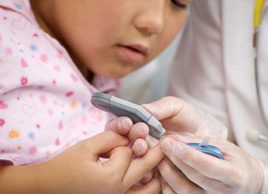8 signs your child may have type 1 diabetes
Concerned your child may have type 1 diabetes? Watch out for these signs

Source: Web exclusive, August 2010
Over 300,000 Canadians have type 1 diabetes, yet when your own child is diagnosed with this disease, it can come as a shock. ‘Most kids who get diabetes do not have another family member with it,’ points out diabetes specialist Dr. Maureen Clement in Vernon, B.C. ‘Often, it’s just a bolt of lightning.’
Type 1 diabetes is usually diagnosed during childhood, often between the ages of 10 to 13. There’s nothing parents can do to prevent this type of diabetes. However, if you notice signs your child might have the disease, you can take action to prevent a serious complication called diabetic ketoacidosis (DKA), in which the body runs out of insulin to process sugar and begins to break down fat instead.
If your child shows indications of type 1 diabetes, says Clement, then don’t delay in visiting your pediatrician. ‘Don’t say, ‘let’s wait a week or two.’ Get your kid tested that day to make sure they don’t have diabetes.’ And if it does turn out that your child is diabetic, remember that as long as the disease is well managed, she can still enjoy good health her whole life. Here’s what to watch out for.
Sign 1: Unquenchable thirst
Children with undiagnosed type 1 diabetes may be constantly thirsty. That’s because as their blood-glucose level rises, fluid is pulled from their body tissues. These kids may especially crave sweet, cold drinks.
Sign 2: Frequent urination
What goes in must come out, so it stands to reason that a child who is drinking more will also visit the washroom more. If your kid is taking an unusual number of bathroom breaks, there may be an underlying and serious reason behind it. A younger child who was previously toilet trained at night may start to wet the bed again.
Sign 3: Weight loss
A body that can’t use the energy from sugar may experience muscle mass and fat loss. The weight loss in a child with undiagnosed type 1 diabetes is often described as sudden and rapid.
Sign 4: Lack of energy
Your child may a feel constantly tired or sluggish because she’s not able to turn the sugar in her bloodstream into energy that her muscles and organs can use.
Sign 5: Intense hunger
When a child’s body is deprived of energy due to low insulin, she may experience the feeling of extreme hunger. However, decreased appetite can also be a warning sign, as it’s one of the symptoms of DKA (see sign 8)
Sign 6: Changes in eyesight
A high blood glucose level causes fluid to be pulled from other body tissues, including eye lenses. This may lead to blurred vision or other eyesight problems. However, a young child may not complain to you about it. ‘They don’t know what normal is, the way adults would,’ says Clement. ‘And some of them aren’t even reading yet.’
Sign 7: Yeast infections
Girls with type 1 diabetes may develop yeast infections. A yeast infection in a baby or toddler may show up as very bad diaper rash.
Sign 8: Diabetic ketoacidosis
DKA can happen in a child with undiagnosed diabetes and is a medical emergency. As the body runs out of insulin for breaking down glucose, it starts to burn fat for energy instead. This leads to a buildup of acidic byproducts called ketones. ‘DKA changes the pH of your blood and is a very dangerous condition,’ notes Clement.
Signs your child is in crisis can include vomiting, stomach pain, fast breathing, flushed face, fruity breath odour and fatigue. DKA may progress very quickly and can be fatal. But it’s also preventable. The more that parents, teachers and camp counsellors are aware of the early signs of diabetes in children, the more likely it is that DKA can be averted.
Don’t miss out! Sign up for our free weekly newsletters and get nutritious recipes, healthy weight-loss tips, easy ways to stay in shape and all the health news you need, delivered straight to your inbox.




